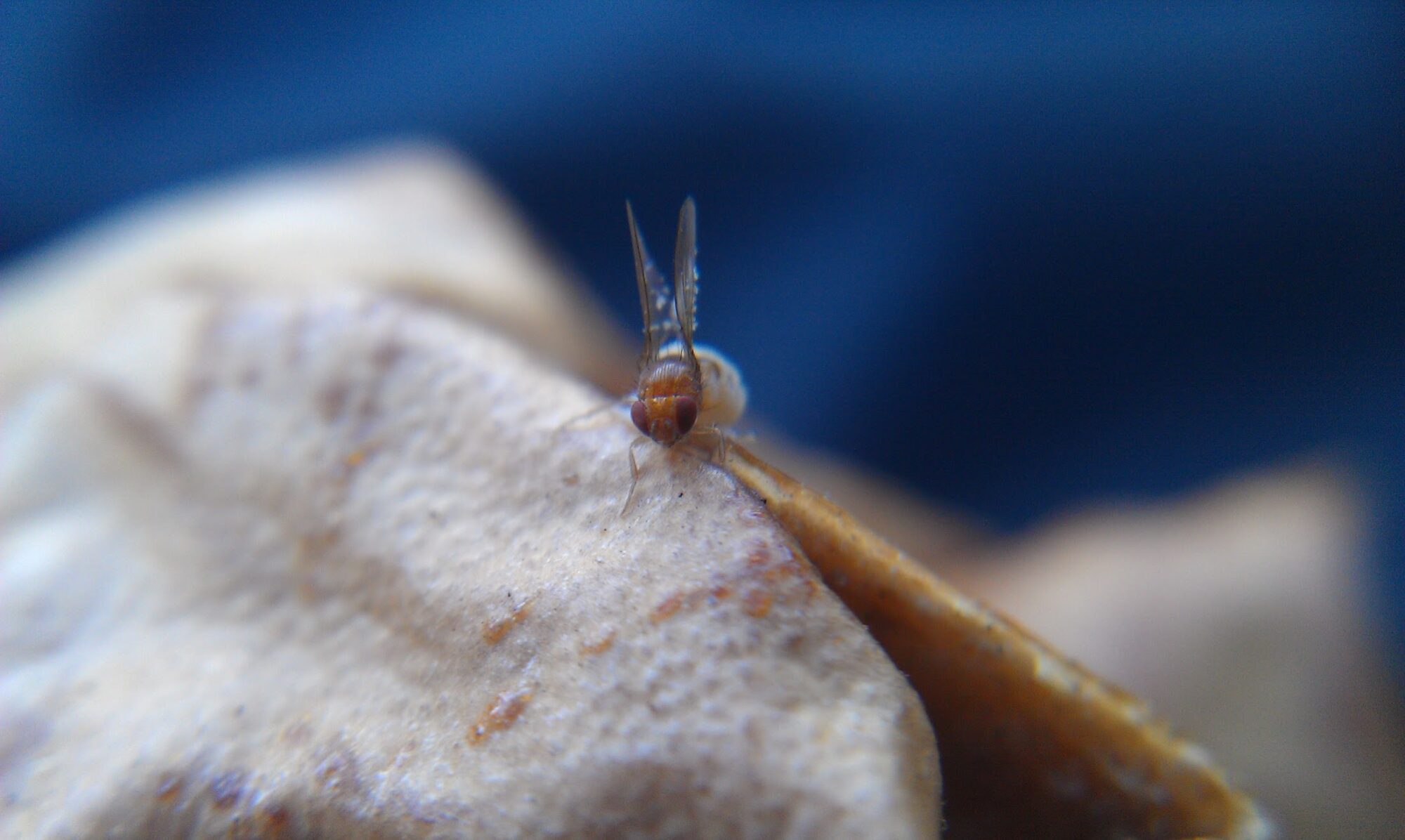Zombie flies can be found wherever you can find flies. Different flies have different preferred habitats.
Fruit flies (Drosophila) are drawn to chemicals produced during fermentation (the process where yeast turns sugar into alcohol and other byproducts). You can find them lurking near compost piles, at wineries, breweries, orchards or even in your own kitchen.
Muscids (e.g., house flies, cluster flies) love decaying matter and poop. You can find them near dumpsters, and compost piles, hanging out at farms and in animal pens, near in outhouses, and near rivers and streams. They also show up in our houses and backyards.
Look for any suspiciously-still flies both inside and out. Hotspots include windows and windowsills, walls, fenceposts, on branches or stems, flowers, and on and under leaves.
The best time of year for finding zombie flies depends on the climate where you live. If flies are out and about, the fungus is too! In colder parts of the US, the best times for zombie flies are late spring (when it’s warm enough outside for flies), summer, and early fall (before it gets too cold). If you live in the southern US, you may have zombies for more of the year, or even year round!
Keep your eyes peeled for flies that are not moving and apparently stuck to the surface. If you’re not sure if the fly is moving, wave your hand over it (a healthy fly will zip away).
If you’re lucky, you will see the classic banding pattern of fungal growth (fuzzy white stuff growing on the fly’s back). But if the fly has been dead for a while, it may be a lot less obvious. In that case, look for spores on the wings (perfect clear circles) as an indication that the fly was killed by Entomophthora.
Ironically, sometimes other fungi come and eat the fungus that killed the fly. This can make it harder (but not impossible!) to ID zombies.
Here are some examples of wild zombies:
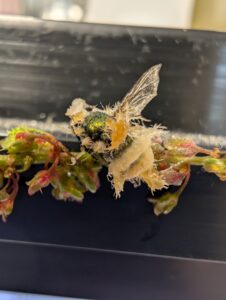
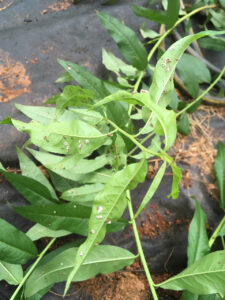
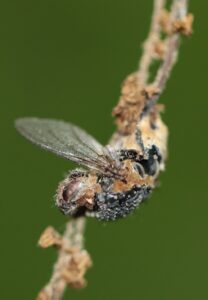
Photo credits (left to right): Thomas Roehl, Priscilla Erickson, Carolyn Elya1. Do a little dance!
2. Take a picture on your phone. Most phones will save the time, date, and location information automatically.
3. Take note of your surroundings – what kind of plant is the fly on? How did you notice it? The more information the better.
4. When you’re ready: carefully pull the fly off of whatever it’s stuck to using a clean hand or tweezers (this fungus won’t hurt you – it’s okay to touch). If it’s okay if some of the leaf/flower/plant part that the fly is stuck to comes with it. Keep in mind that many common plants can irritate your skin. If you use bare hands to collect, be sure to wash your hands with soap and water after handling your specimen!
Place each individual specimen in its own clean container (e.g., ziploc baggie, test tube, small tupperware).
5. We strongly encourage you to post your observation to iNaturalist to share with the broader community.
6. Go onto our website and fill out the specimen inquiry form. If you’ve already posted to iNaturalist, you just need to share the link to your observation. If you haven’t posted your observation on iNaturalist, we will ask you to upload a photo and tell us more about it.
7. Please be patient while we review your sample. We will reach out to you and let you know how we’d like to proceed. If we’re interested in receiving your specimen, we will send you prepaid postage so all you have to do is drop it in the mail.
You can store your sample in a cool, dark, dry place. Putting in the fridge is okay. Avoid introducing or trapping moisture with your sample- it will encourage more fungus (and other microbes) to grow.
PLEASE DO NO PUT YOUR SAMPLE IN THE FREEZER. Freezing damages tissue and will make identifying visible features challenging.
Yes! We welcome multiple samples being shipped at the same time. Please be sure to keep each specimen in its own container to avoid cross-contamination.
If you are lucky enough to come across an outbreak, we would love if you could collect multiple samples. Doing so will help us ensure that we can identify both host and fungus.
Outbreak example:
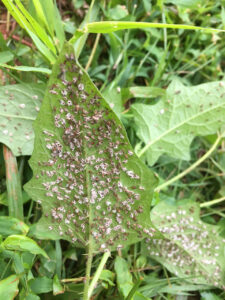
Photo: Priscilla EricksonWe will send you a shipping label and instructions!
Please be sure to label each container with their assigned samples IDs. This will help us keep track of everything.
Upon receipt of your sample, we will image the specimen(s) and extract fungal material for diagnostic staining.
We will use the rest of your sample to extract DNA and identify the host and fungal species.
If you’re interested in the details of how we process specimens, stay tuned. We will soon be sharing a slide deck that dives into all of the specifics.
Yes! We will post all of our data – images, cells, and sequences.
Our goal is to amass a large collection of matched host and fungal sequences so that we can look for trends in host specificity among strains and evaluate co-evolution of fungus and their insect hosts.
Anyone who submits samples will be inducted as members of the Zombuddies consortium and will be included as a co-author on any resultant publications.
Unless you or your loved ones are an insect, there is no reason to fear these fungi. They are specialized to attack, infect and kill insects, which lack an adaptive immune system and are also unable to maintain high body temps like we do. That said, be mindful of the plants you may be sampling from and always wash your hands after handling specimens.
Send Dr. Elya an email! You can reach her at cnelya at g.harvard.edu. Be sure to put “Zombuddies” in the subject line.
